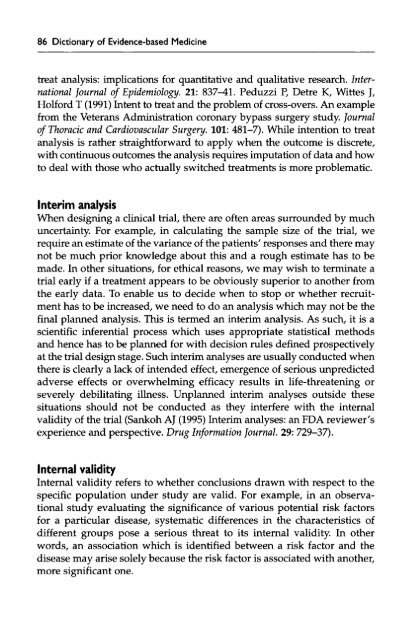Dictionary of Evidence-based Medicine.pdf
Dictionary of Evidence-based Medicine.pdf
Dictionary of Evidence-based Medicine.pdf
You also want an ePaper? Increase the reach of your titles
YUMPU automatically turns print PDFs into web optimized ePapers that Google loves.
86 <strong>Dictionary</strong> <strong>of</strong> <strong>Evidence</strong>-<strong>based</strong> <strong>Medicine</strong><br />
treat analysis: implications for quantitative and qualitative research. International<br />
Journal <strong>of</strong> Epidemiology. 21: 837-41. Peduzzi P, Detre K, Wittes },<br />
Holford T (1991) Intent to treat and the problem <strong>of</strong> cross-overs. An example<br />
from the Veterans Administration coronary bypass surgery study. Journal<br />
<strong>of</strong> Thoracic and Cardiovascular Surgery. 101: 481-7). While intention to treat<br />
analysis is rather straightforward to apply when the outcome is discrete,<br />
with continuous outcomes the analysis requires imputation <strong>of</strong> data and how<br />
to deal with those who actually switched treatments is more problematic.<br />
Interim analysis<br />
When designing a clinical trial, there are <strong>of</strong>ten areas surrounded by much<br />
uncertainty. For example, in calculating the sample size <strong>of</strong> the trial, we<br />
require an estimate <strong>of</strong> the variance <strong>of</strong> the patients' responses and there may<br />
not be much prior knowledge about this and a rough estimate has to be<br />
made. In other situations, for ethical reasons, we may wish to terminate a<br />
trial early if a treatment appears to be obviously superior to another from<br />
the early data. To enable us to decide when to stop or whether recruitment<br />
has to be increased, we need to do an analysis which may not be the<br />
final planned analysis. This is termed an interim analysis. As such, it is a<br />
scientific inferential process which uses appropriate statistical methods<br />
and hence has to be planned for with decision rules defined prospectively<br />
at the trial design stage. Such interim analyses are usually conducted when<br />
there is clearly a lack <strong>of</strong> intended effect, emergence <strong>of</strong> serious unpredicted<br />
adverse effects or overwhelming efficacy results in life-threatening or<br />
severely debilitating illness. Unplanned interim analyses outside these<br />
situations should not be conducted as they interfere with the internal<br />
validity <strong>of</strong> the trial (Sankoh AJ (1995) Interim analyses: an FDA reviewer's<br />
experience and perspective. Drug Information Journal. 29: 729-37).<br />
Internal validity<br />
Internal validity refers to whether conclusions drawn with respect to the<br />
specific population under study are valid. For example, in an observational<br />
study evaluating the significance <strong>of</strong> various potential risk factors<br />
for a particular disease, systematic differences in the characteristics <strong>of</strong><br />
different groups pose a serious threat to its internal validity. In other<br />
words, an association which is identified between a risk factor and the<br />
disease may arise solely because the risk factor is associated with another,<br />
more significant one.










